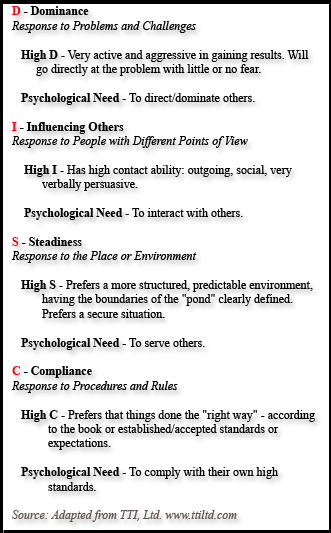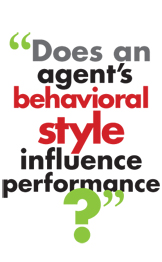DISC Behavioral Styles and Sales Performance
by Kirk Wakefield, Ph.D.
Does an agent's behavioral style influence performance? Do groups or offices work better if there is an appropriate mix of individuals with different behavioral styles? What is a behavioral style in the first place? Let's answer the last question first. The focus of behavioral styles is not so much on personality, values, or beliefs, but on what you say or do. How you tend to act in response to problems, people, places, and procedures gives us a good idea of who you really are. One of the most popular methods to measure behavioral style is the DISC model, which classifies individuals based on the four dimensions (see table) of dominance, influence, steadiness, and compliance. 
Should your office blend individuals with varying behavioral styles?
It seems obvious that an office staffed completely by high I's would risk productivity unless output was measured by spoken words per minute. Given that individuals with high D characteristics are high risk takers, it makes sense that having a high C around would provide needed balance. In general, arranging work groups with complementary behavioral styles is thought to be more productive, as it should increase flexibility in dealing with various kinds of customers, responsibilities, and challenges. Surprisingly, no research evidence exists to support this belief . The Keller Center intends to answer the question of effective teams more definitively in future research regarding DISC behavioral styles.
Initial Study: Do High D's Perform Better?
The starting point in the Keller Center's ongoing research regarding DISC behavioral styles and performance is to begin investigating the effects of behavioral styles on performance among sales people. In particular, we are interested in learning if an individual's adapted style, versus natural style, predicts sales performance. Your natural style is just that -- how you behave naturally, particularly when under pressure and unable to adapt. Adapted style is how you behave in your current work environment in order to do what you believe is necessary to succeed. If the difference between your natural and adapted style represents a dramatic shift, you are likely to be stressed out. Working with Target Training International (find out more about TTI at www.ttiltd.com), we gathered an initial round of data from over 100 sales professionals and sales managers. In addition to measuring natural and adapted behavioral styles, we also measured other individual factors known to influence productivity and performance. Each of these is one of the GATES to successful selling: 1. Goal clarity: the extent to which expectations, goals, and output are clearly defined for the job. 2. Adaptive selling skills: flexibility in approaches to match the customer. 3. Training: clear understanding and expectations regarding how to interact, serve, resolve issues, and communicate with customers. 4. Experience: number of years in the current position. 5. Self-Efficacy: the level of confidence an individual has in one's own selling abilities. Note that each of these is controllable. Managers and individuals can change or improve upon each of these, though some take more time or are more difficult than others to acquire. In contrast, a reason we are interested in understanding the effects of DISC dimensions is that your natural behavioral style tends to remain consistent over time -- and there is a limit to adapting your style before turning into a basket case. In this study, we measured performance along six dimensions: 1. Generating a high level of dollar sales 2. Quickly generating sales from new offers 3. Identifying qualified prospects and contacting them 4. Exceeding sales targets 5. Assisting the manager to meet his/her goals 6. Contributing to the group's sales performance We also collected information regarding each individual's total annual earnings, finding that this measure of performance is strongly correlated with reported annual individual income. and embrace personal challenges. Many are also high I's, who use persuasive skills to influence others. Conversely, High C's tend to shy away from high levels of personal interaction (low I) and take criticism and "no's" personally. Since many high C's are also high S's, who tend to be sensitive to the needs of others and seek security and safety (generally good traits for developing good relationships), we were not particularly optimistic that High S's would perform well in sales.
and embrace personal challenges. Many are also high I's, who use persuasive skills to influence others. Conversely, High C's tend to shy away from high levels of personal interaction (low I) and take criticism and "no's" personally. Since many high C's are also high S's, who tend to be sensitive to the needs of others and seek security and safety (generally good traits for developing good relationships), we were not particularly optimistic that High S's would perform well in sales.
Early Findings
Accounting for all of the individual factors and behavioral style dimensions, the strongest determinant of sales performance was self-efficacy or confidence in your own selling ability. This is not unexpected. We thought each of the individual factors had potential for explaining performance. Somewhat surprisingly, aside from two behavioral dimensions, the only other significant determinant of performance was experience. As individuals persist in the business and gain experience, performance tends to increase or the individual gets out. What about behavioral styles? The early results of our studies confirm one expectation and partially disconfirm another. Individuals with higher dominance (D) behavioral traits perform better than those who are low D's. Since this is the first published study we could find of this kind, we seek further data collection to confirm this finding across sales and business settings.
Does this mean that only High D's will succeed in sales?
No. Indeed, we found individuals within our sample who possessed relatively low dominance (D) traits but who also perform well in sales. So, it can be done. In particular, our findings suggest that those who have gained experience and confidence in their selling skills are particularly strong performers. The kicker is, however, that our data shows that High D's are more likely to be confident in their selling abilities.
What about the other behavioral styles?
We found no significant relationship between the level of Influence (I) or Compliance (C) with performance. So, High I's or High C's could be successful in sales, but it is not related to their behavioral style. Surprisingly, we found that those with higher levels of steadiness (S) were apt to be better performers. This makes sense. The servant's heart of a high S should lead to good customer service. After closer investigation, however, it was determined that only those with a moderate level of the S behavioral style performed well. The results indicate that those at the highest end of the steadiness dimension perform very poorly--likely due to the fact that successful selling requires good service after the sale, but that cannot substitute for finding and closing business.
Future Research
The Keller Center will continue to report on research and findings in the area of DISC behavioral styles and its effects on performance and other important elements of successful operations. In future issues, we will also examine how DISC styles influence job satisfaction and relate to other workplace motivators.
. . . . . . . . . . . . . . . . . . .
About the Author:
Kirk Wakefield, Ph.D., Professor of Marketing, Baylor University
Director, Keller Center for Research
Dr. Wakefield's current research focuses on (1) valuation of sponsorships, (2) marketing of music & films, and (3) how fans process information and make decisions. His book on Team Sports Marketing and 50+ publications (including Journal of Marketing, Journal of Retailing, Journal of Advertising, Journal of Leisure Sciences, Journal of Advertising Research, Journal of Business Research, and others) involve conducting research in virtually every professional sport (NASCAR, ATP Tennis, anything with a ball or puck) and with teams such as the San Antonio Spurs, Dallas Mavericks, Texas Rangers, Houston Rockets, Houston Texans, and San Francisco 49ers.